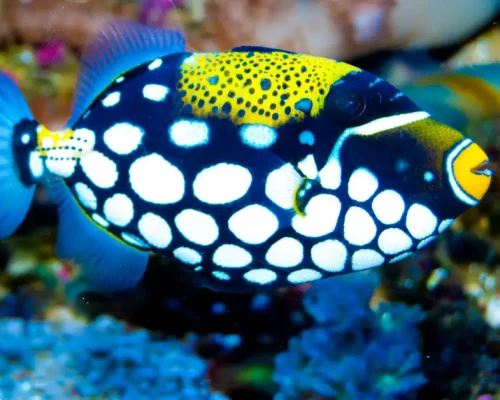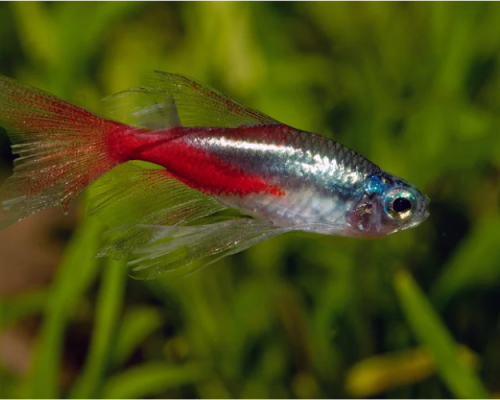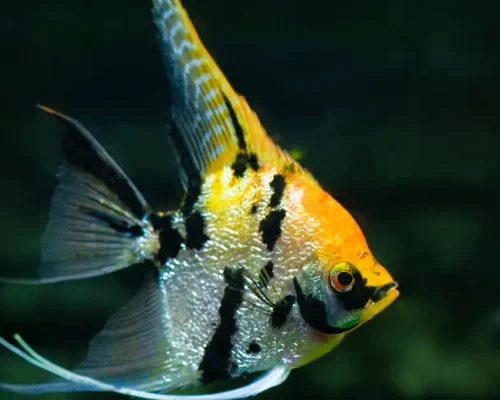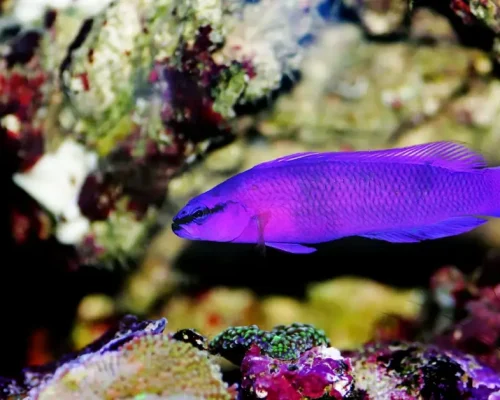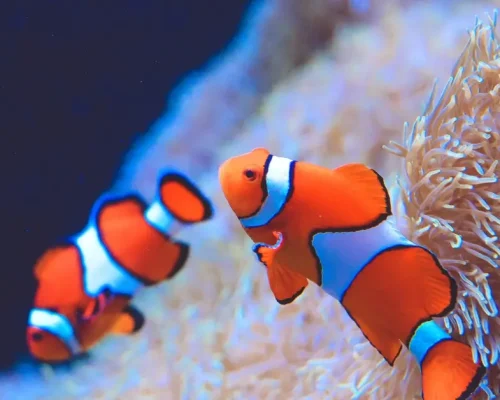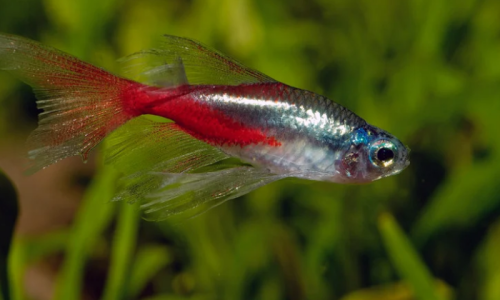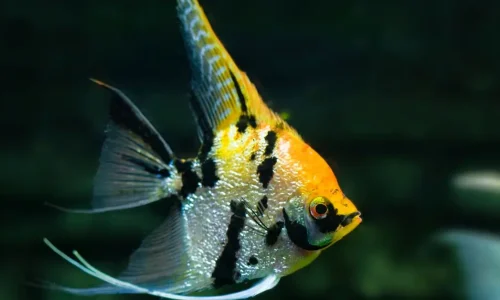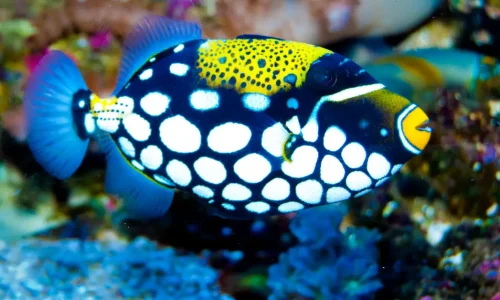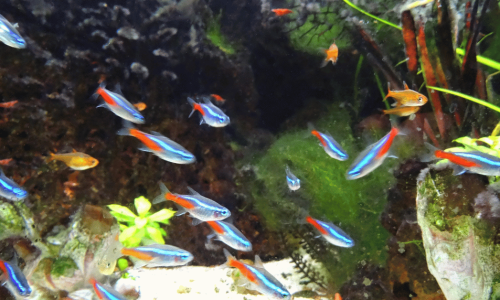Table of Contents
ToggleIntroduction to Angelfish
What are angelfish?
Angelfish are a dazzling centerpiece for both freshwater and saltwater aquariums. Known for their graceful, triangular bodies, flowing fins, and mesmerizing colors, they add an air of elegance to any underwater environment. These fascinating cichlids (a family of fish) come in a fantastic range of species, allowing hobbyists to choose the perfect fit for their tank.
Angelfish in the wild
In their native habitat, primarily the Amazon River basin in South America, angelfish glide through dense vegetation and root systems. Their flattened bodies are ideal for navigating these intricate environments. In the wild, their stripes and patterns help them blend in, providing camouflage from predators.
Why are they popular aquarium fish?
Angelfish have captivated aquarists for decades. Their stunning appearance is only part of their charm. They are relatively hardy, display interesting behaviors, and with proper care, can thrive in the home aquarium.
Angelfish Species Overview
Let’s dive into the fascinating world of angelfish species. While there are many varieties, we’ll focus on some of the most popular choices for aquarium enthusiasts.
Freshwater Angelfish
- Common Angelfish (Pterophyllum scalare): The classic angelfish! They come in an array of colors and patterns like silver, zebra, koi, and black lace. They’re generally adaptable and a good starting point for angelfish keepers.
- Altum Angelfish (Pterophyllum altum): Instantly recognizable by their tall, deep body. Altums are a bit more demanding, but their majestic presence rewards experienced aquarists.
- Koi Angelfish: A favorite for their vibrant splashes of orange, red, and white reminiscent of koi fish.
- Veil Angelfish: Their elongated, flowing fins are truly a sight to behold.
Saltwater Angelfish
- Emperor Angelfish: Their color transformation from juvenile to adult is breathtaking. Juveniles are dark blue with white circles, while adults sport brilliant yellow and blue stripes.
- Queen Angelfish: This Caribbean beauty boasts iridescent blue and yellow scales, with a distinctive crown spot on its forehead.
- French Angelfish: Their dark gray bodies with striking yellow accents make them stand out in a reef tank.
- Regal Angelfish: A classic saltwater species with vivid blue, yellow, and white stripes.
Angelfish Appearance
Body Shape and Features
The most striking feature of all angelfish is their distinctive body shape. They are laterally compressed, meaning they’re incredibly flat from side to side. This unique shape makes them masters of navigating dense vegetation and roots in their natural environment. Their flowing dorsal and anal fins add a touch of flowing elegance to their movements.
Color Variations
Angelfish are a kaleidoscope of colors and patterns! Freshwater angelfish often comes in silver varieties accented with stunning stripes or marbled patterns. You’ll find zebra angelfish, smokey angelfish, black lace angelfish, and even those with dazzling gold or koi patterns. Saltwater angelfish tends to be even more vibrant, sporting blues, yellows, oranges, purples, and even iridescent scales.
How to Distinguish Males and Females
Telling male and female angelfish apart can be tricky. In most species, there are very subtle differences in body shape or fin length. During the breeding season, you might notice a small breeding tube emerge in females, used for laying eggs. However, sexing angelfish is often best left to experienced breeders when visual identification is tough.
Angelfish Lifespan
Average Lifespan in Captivity
With excellent care, your angelfish can be a delightful companion for many years. On average, most angelfish species can live for 10-15 years in a well-maintained aquarium setting.
Factors Affecting Lifespan
- Water quality: Angelfish thrive in clean, stable water conditions.
- Diet: A balanced and nutritious diet is essential for their health and longevity.
- Stress: Minimize stress levels by providing a suitable tank environment and compatible tankmates.
- Genetics: Some angelfish may naturally have a longer lifespan than others.
Angelfish Size
Average Sizes of Different Species
Angelfish come in a range of sizes. Freshwater species generally stay smaller than their saltwater counterparts. Here’s a ballpark idea:
- Common Angelfish: Can reach about 6 inches in length and 8 inches in height (including fins).
- Altum Angelfish: Grow taller (up to 10 inches from top to bottom) but often remain slimmer.
- Saltwater Angelfish (like Emperor or Queen): can reach a foot in length or more.
Growth Rate
Angelfish growth rate depends on species, water quality, diet, and genetics. Young angelfish grow rapidly within their first year, then growth slows. Ensuring they get enough quality food will influence how large they ultimately get.
Angelfish Care Guide
Setting up a thriving environment for your angelfish is key to their health and happiness.
Let’s break down the essentials!
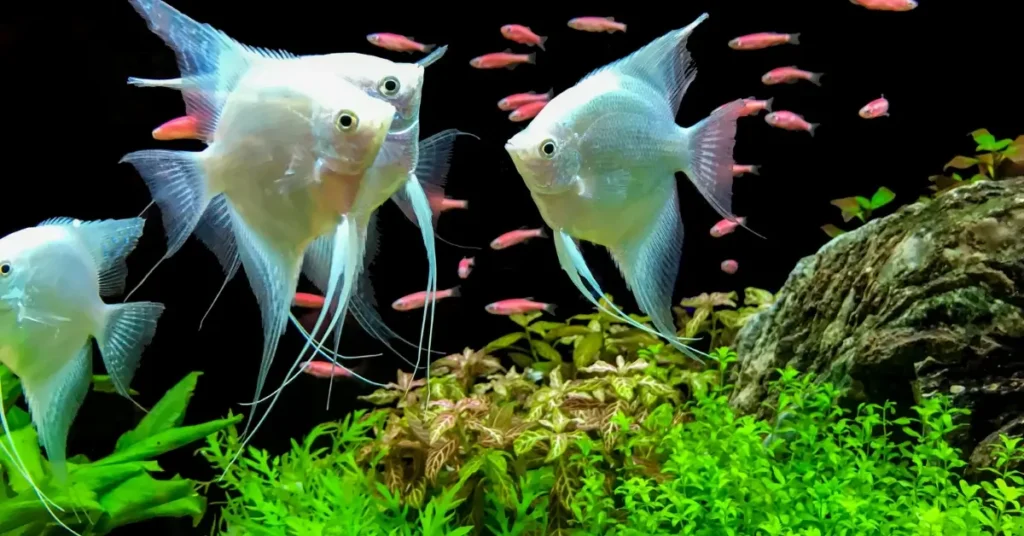
Tank Size
Angelfish, especially as they grow, need ample space. For a small group of freshwater angelfish, a minimum of a 29-gallon tank is generally the starting point. Larger is always better! As angelfish get taller, a high tank accommodates their body shape. For saltwater angelfish, significantly larger tanks (75 gallons or more) become necessary due to their size.
Water Parameters
Angelfish favor slightly warmer, softer water with a bit of acidity:
- Temperature: 75-82°F (24-28°C)
- pH: 6.8-7.8
- Hardness: 3–8 dKH (general hardness)
Maintaining stable water parameters is crucial. Invest in a good aquarium test kit to monitor levels regularly.
Tank Setup (Decor, Plants)
Angelfish love a planted tank that mimics their natural habitat! Here are some ideas:
- Substrate: Sand or fine gravel is gentle on their fins.
- Plants: Tall plants like Amazon swords, Vallisneria, and Java ferns.
- Decor: Driftwood, caves, or other structures provide hiding spots and security.
Filtration
A high-quality filter suited to your tank size is a must! Angelfish can be somewhat messy
eaters, so a filter that keeps up with waste and maintains excellent water quality is key.
Water Changes and Maintenance
Regular partial water changes (20–25% weekly) are vital to remove waste and replenish
essential minerals in the water. Remember to use properly conditioned water to replace
what you’ve taken out.
Angelfish Diet
Natural Diet
In the wild, angelfish are omnivores, feasting on small insects, larvae, crustaceans, and
some plant matter.
Best Foods for Angelfish
In your aquarium, aim for a varied diet:
- Flakes/Pellets: Choose a high-quality food formulated for angelfish.
- Frozen Foods: Bloodworms, brine shrimp, and mysis shrimp are angelfish favorites.
- Live Foods: Great as an occasional treat (brine shrimp, blackworms).
- Blanched vegetables: Zucchini or spinach, provide supplemental nutrients.
Feeding Frequency
Feed your angelfish small amounts 2-3 times a day. Only offer what they can eat within
a few minutes to prevent overfeeding and leftover food from spoiling your water quality.
Angelfish Behavior and Temperament
Peaceful or Aggressive?
Angelfish fall somewhere in between. Generally, they are semi-aggressive fish. While they might display the occasional chase or fin nip, serious damage is less common within the right setup. This also varies between species, with some saltwater angelfish being more territorial than their freshwater cousins.
Social Behavior
Angelfish enjoy living in groups and establish their own hierarchy within the tank. You’ll often see a dominant pair form, especially when nearing breeding season. Angelfish are fascinating to watch as they interact with each other!
Compatibility with Other Fish
Choosing tank mates carefully is crucial for a peaceful angelfish community. Here’s
What to consider:
- Size: Avoid fish small enough to be seen as snacks by your angelfish.
- Temperament: Stick with equally peaceful or semi-aggressive fish.
- Tank regions: Combine fish that occupy different tank levels (angelfish love the middle).
Angelfish Tank Mates
Ideal Tank Mates
Here are some generally good companions for angelfish:
- Tetras: Many larger tetra species work well (neon tetras, black skirt tetras, etc.).
- Peaceful Catfish: Corydoras and similar bottom dwellers are safe.
- Gourami: Most gourami species can coexist with angelfish.
- Other Cichlids: Similar-sized, less aggressive dwarf cichlids could be suitable.
Fish to Avoid
- Small, delicate fish: Angelfish might see them as food.
- Fin-nippers: like tiger barbs or some other barbs.
- Highly aggressive fish
Important Note: Every fish has an individual personality! Always observe any new tank
additions closely.
Breeding Angelfish
Breeding angelfish can be a rewarding experience, but it comes with its own set of challenges. Here’s an overview of the process:
Challenges of Breeding
- Identifying Sex: As mentioned earlier, telling males and females apart is difficult, especially with young angelfish.
- Pairing Up: Angelfish choose their own mates. If you don’t have luck with a pair forming, you might need to try different individuals.
- Raising Fry: Angelfish fry are delicate and require specialized care.
Setting Up a Breeding Tank
If you’re serious about breeding, a separate breeding tank is essential. Here’s what you’ll need:
- Size: 20 gallons minimum for a pair.
- Bare-bottom: Easier to keep clean for the delicate fry.
- Spawning Slate: A vertical surface like a slate or PVC pipe where they’ll lay
- eggs.
- Filtration: Use a gentle sponge filter to protect the tiny fry.
Caring for Angelfish Fry
- Feeding: Newly hatched fry starts with infusoria (microscopic food) and gradually moves to baby brine shrimp.
- Water Changes: Frequent, small water changes are crucial in the fry tank.
- Growth: As they grow, you can gradually move them to larger tanks.
Important Note: Angelfish parents sometimes eat their eggs or fry. If this happens repeatedly, you might need to take over raising the fry by hand, a process that becomes much more specialized.
Common Angelfish Diseases
Like many aquarium fish, angelfish are susceptible to certain diseases. Being observant, maintaining optimal water conditions, and quarantining new fish are your best defenses.
Identifying Signs of Illness
Look for these changes that might indicate your angelfish is unwell:
- Lethargy or hiding excessively
- Loss of appetite or refusing food
- Color changes or fading
- White spots, fuzzy growths, or open sores on the body
- Clamped fins (held tightly against the body)
- Rapid breathing or gasping at the surface
Common Diseases and Treatments
Here are some common angelfish ailments:
- Ich (White Spot Disease): Parasitic. Look for white specks covering the fish. Raise the water temperature and treat with medication.
- Fin Rot: Bacterial infection. Frayed, darkened fins. Improve water quality, and use antibacterial treatments.
- Hole-in-the-Head: Causes lesions on the head. Often linked to poor water quality and diet.
- Flukes: Tiny parasitic worms, fish may rub against objects to try and dislodge
- them. Requires specialized medication.
Preventative Measures
The best way to deal with fish diseases is to prevent them! Here’s how:
- Quarantine: Always isolate new fish for a few weeks before adding them to your main tank.
- Cleanliness: Regular water changes and tank maintenance are key.
- Quality Food: A balanced diet boosts your angelfish’s immune system.
- Reduce stress: Provide hiding places and suitable tank mates.
Important: If you suspect your angelfish is sick, isolate them if possible and consult an
aquarium expert or veterinarian for accurate diagnosis and the best course of treatment.
Conclusion
Angelfish are truly captivating creatures that bring a touch of underwater elegance to
any aquarium. By providing them with optimal care, understanding their unique needs,
and appreciating their different species, you’ll enjoy the company of these remarkable
fish for years to come!
Can angelfish live with tetras?
Yes! Many larger tetras make excellent tank mates for angelfish.
Are angelfish easy to care for?
They’re considered moderately easy fish to keep. While not beginner-level, they thrive in stable conditions if their needs are met.
How many angelfish can I keep together?
It depends on your tank size. Generally, start with a group of at least 4-6 to establish a hierarchy.
Do angelfish need live plants?
Live plants are not required but are highly appreciated by angelfish as they mimic their natural environment.
How often do I need to feed my angelfish?
Feed angelfish in small amounts 2-3 times a day.


